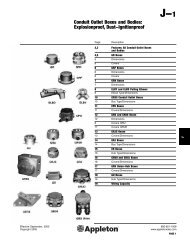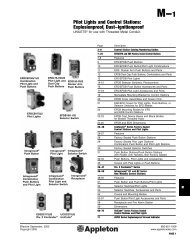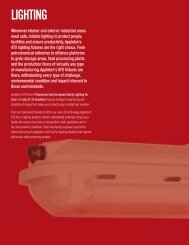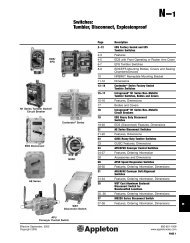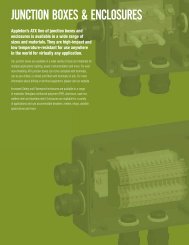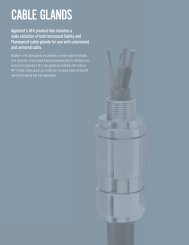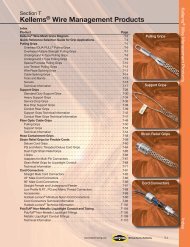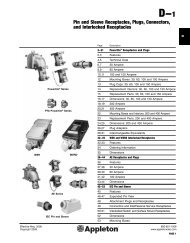W3-Explosionproof Reelites
W3-Explosionproof Reelites
W3-Explosionproof Reelites
Create successful ePaper yourself
Turn your PDF publications into a flip-book with our unique Google optimized e-Paper software.
A cast threaded junction box completes the special construction<br />
of explosionproof <strong>Reelites</strong> (Fig. 4). This external junction<br />
box provides ample working room to allow the electrician to<br />
make incoming connection to the reel. The threaded cast<br />
cover plus factory-potted leads to the reel protect against<br />
any accidental sparking within the junction box chamber<br />
during operation.<br />
Fig. 4—Close-up view of external cast junction box for easy<br />
field installation.<br />
Dust build-up on the cast housing or cover does not present<br />
a danger since there is ample air space within the cover, and<br />
the operating temperature on the surface of the cover is well<br />
below the ignition point for approved dust and flyings listed.<br />
Those explosionproof reels requiring cable locking ratchets<br />
are supplied with a combination of materials which will be<br />
“non-sparking.”<br />
GUIDE TO HAZARDOUS LOCATIONS<br />
The following guide to hazardous locations offers a<br />
condensed description of National Electrical Code classifications<br />
and is to be used for general information only and does<br />
not imply that explosionproof <strong>Reelites</strong> are suitable for any<br />
classification other than previously listed.<br />
Class I Locations are those where flammable gases or<br />
vapors are or may be present in the air in quantities sufficient<br />
to produce explosive or ignitable mixtures.<br />
Class I, Division 1 Locations are those where such<br />
hazardous concentrations of flammable gases or vapors<br />
exist continuously, intermittently, or periodically under normal<br />
operating conditions.<br />
Class I, Division 2 Locations are those where such<br />
hazardous concentrations of flammable gases or vapors are<br />
handled in closed containers or piping systems and present<br />
a danger only in the case of accidental rupture, breakage,<br />
or unusual faulty operation.<br />
Effective September, 2005<br />
Copyright 2005<br />
<strong>W3</strong>-51<br />
Reelite ® Applications For Hazardous Locations<br />
(cont’d)<br />
Class II Locations are those where the presence of<br />
combustible dust presents a fire or explosion hazard.<br />
Class II, Division 1 Locations are those where dust is<br />
suspended in the air continuously, intermittently, or periodically<br />
under normal operating conditions, in quantities<br />
sufficient to produce explosive or ignitable mixtures.<br />
Class II, Division 2 Locations are those where such dust is<br />
not suspended in the air, but where deposits of it accumulating<br />
on the electrical equipment will interfere with the safe<br />
dissipation of heat, causing a fire hazard.<br />
Class III Locations are those where easily ignitable fibers or<br />
flyings are present but are not likely to be suspended in the<br />
air in quantities sufficient to produce ignitable mixtures.<br />
Class III, Division 1 Locations are those where ignitable<br />
fibers or materials producing combustible flyings are handled,<br />
manufactured, or used.<br />
Class III, Division 2 Locations are those where easily ignited<br />
fi bers are stored or handled (except in process of manufacture).<br />
Further refinement created for the purpose of testing and<br />
approving electrical equipment divides Class I into four separate<br />
designations (A, B, C, and D) and divides Class II into<br />
three separate designations (E, F, and G).<br />
Class I, Group A: Atmospheres containing acetylene.<br />
Class I, Group B: Atmosphere containing butadiene,<br />
ethylene oxide, hydrogen, manufactured gases containing<br />
more than 30% hydrogen (by volume), propylene oxide.<br />
Class I, Group C: Atmospheres containing acetaldehyde,<br />
cyclopropane, diethyl ether, ethylene, unsymmetrical dimethyl<br />
hydrazine (UDMH 1, 1-dimethyl hydrazine).<br />
Class I, Group D: Atmospheres containing acetone,<br />
acrylonitrile, ammonia, benzene, butane, 1-butanol (butyl<br />
alcohol), 2-butanol (secondary butyl alcohol), n-butyl acetate,<br />
isobutyl acetate ethane, ethanol (ethyl alcohol), ethyl acetate,<br />
ethylene dichloride, gasoline, heptanes, hexanes, isoprene,<br />
methane (natural gas), methanol (methyl alcohol), 3-methyl-1butanol<br />
(isoamyl alcohol), methyl ethyl ketone, methyl isobutyl<br />
ketone, 2-methyl-1-propanol (isobutyl alcohol), 2-methyl-2propanol<br />
(tertiary butyl alcohol), petroleum naptha, octanes,<br />
pentanes, 1-pentanol (amyl alcohol), propane, 1-propanol<br />
(propyl alcohol), 2-propanol (isopropyl alcohol), propylene,<br />
styrene, toluene, vinyl acetate, vinyl chloride, xylenes.<br />
Class II, Group E: Atmospheres containing metal dust,<br />
including aluminum, magnesium, and their commercial alloys,<br />
and other metals of similarly hazardous characteristics.<br />
Class II, Group F: Atmospheres containing carbon black,<br />
coal or coke dust with more than 8% volatile material.<br />
Class II, Group G: Atmospheres containing flour, starch,<br />
or grain dusts.<br />
800-621-1506<br />
www.appletonelec.com<br />
PAGE 51<br />
W



